oil viscosity CHEVROLET CAMARO 1994 4.G Owners Manual
[x] Cancel search | Manufacturer: CHEVROLET, Model Year: 1994, Model line: CAMARO, Model: CHEVROLET CAMARO 1994 4.GPages: 292, PDF Size: 15.35 MB
Page 101 of 292
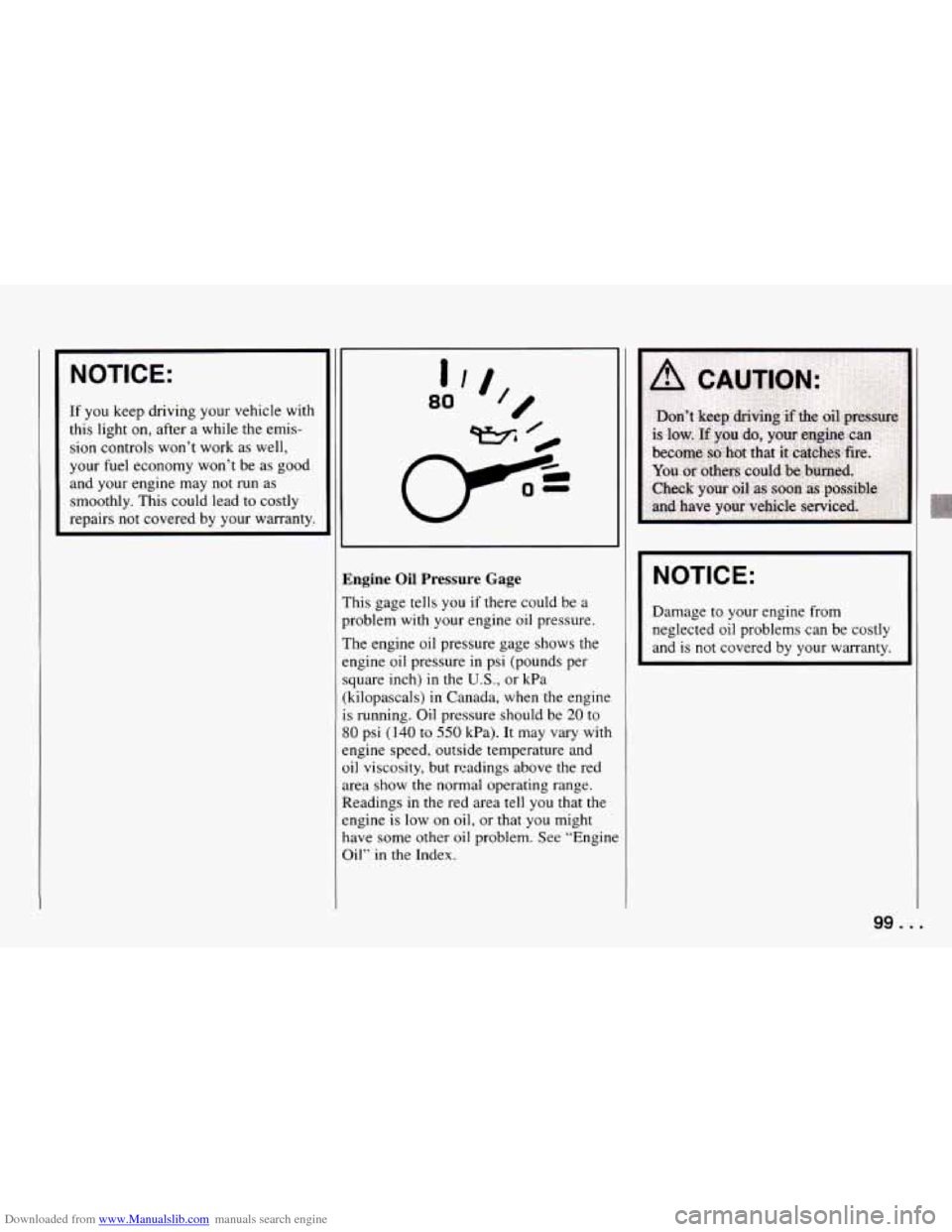
Downloaded from www.Manualslib.com manuals search engine NOTICE:
If you keep driving your vehicle with
this light on, after a while the emis-
sion controls won’t work as well,
your fuel economy won’t be as good
and your engine may not run as
smoothly. This could lead to costly
repairs not covered by your warranty. 80 I// //
~~
Engine Oil Pressure Gage
This gage tells you if there could be a
problem with your engine oil pressure.
The engine oil pressure gage shows the
engine oil pressure in psi (pounds per
square inch)
in the U.S., or kPa
(kilopascals) in Canada, when the engine
is running. Oil pressure should be
20 to
80 psi (140 to 550 kPa). It may vary with
engine speed, outside temperature and
oil viscosity, but readings above the red
area show the normal operating range.
Readings in the red area tell you that the
engine is low on oil, or that you might
have some other
oil problem. See “Engine
Oil”
in the Index.
~~~
NOTICE:
Damage to your engine from
neglected oil problems can be costly
and is not covered by your warranty.
99 ...
Page 191 of 292
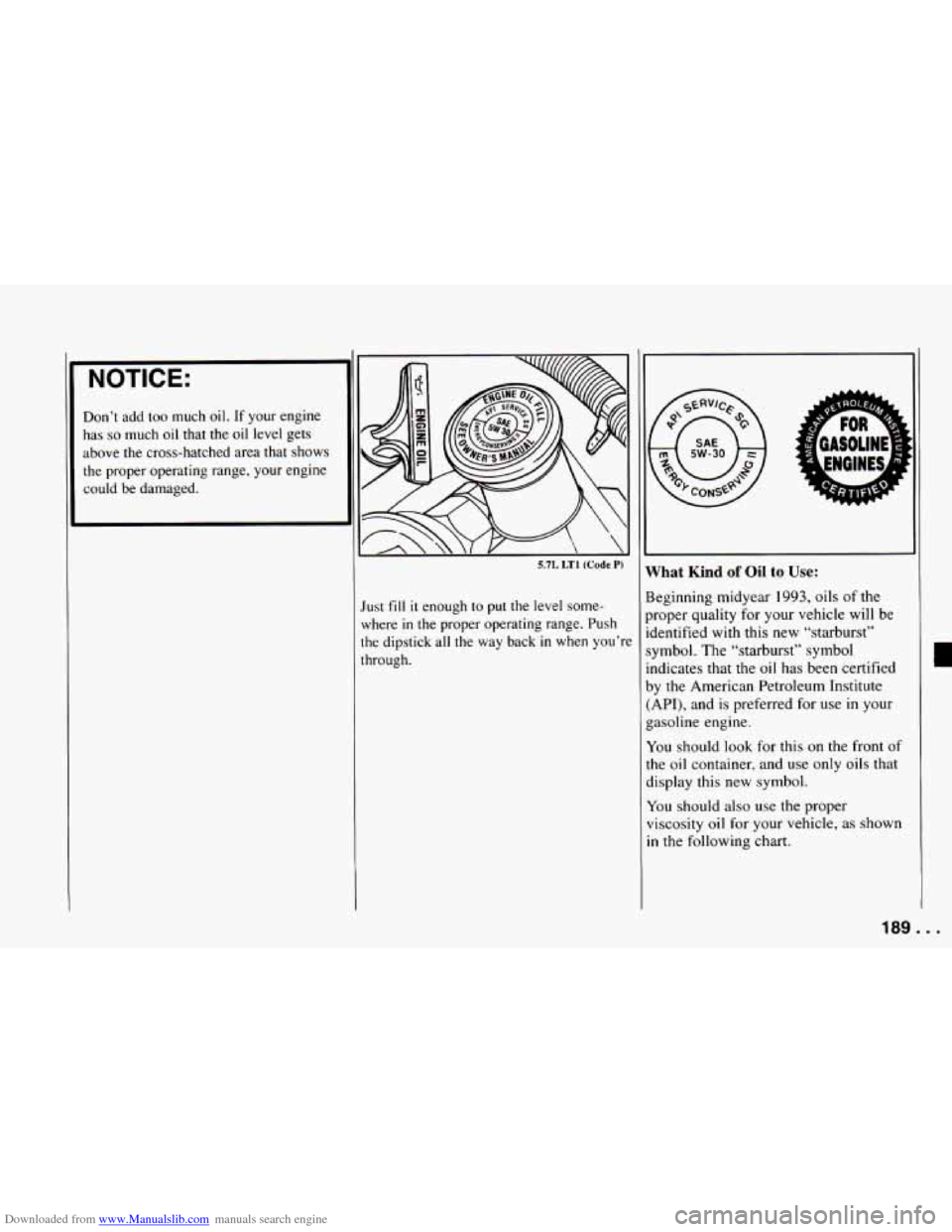
Downloaded from www.Manualslib.com manuals search engine NOTICE:
Don’t add too much oil. If your engine
has
so much oil that the oil level gets
above the cross-hatched area that shows the proper operating range, your engine
could be damaged.
5.7L LT1 (Code P)
lust fill it enough to put the level some-
where
in the proper operating range. Push
:he dipstick all the
way back in when you’re
:hrough.
What Kind of Oil to Use:
Beginning midyear 1993, oils of the
proper quality for your vehicle will be
identified with
this new “starburst”
symbol. The “starburst” symbol
indicates that the
oil has been certified
by the American Petroleum Institute
(API), and
is preferred for use in your
gasoline engine.
You should look for this on the front of
the
oil container, and use only oils that
display this new symbol.
You should also use the proper
viscosity
oil for your vehicle, as shown
in the following chart.
189.. .
Page 192 of 292
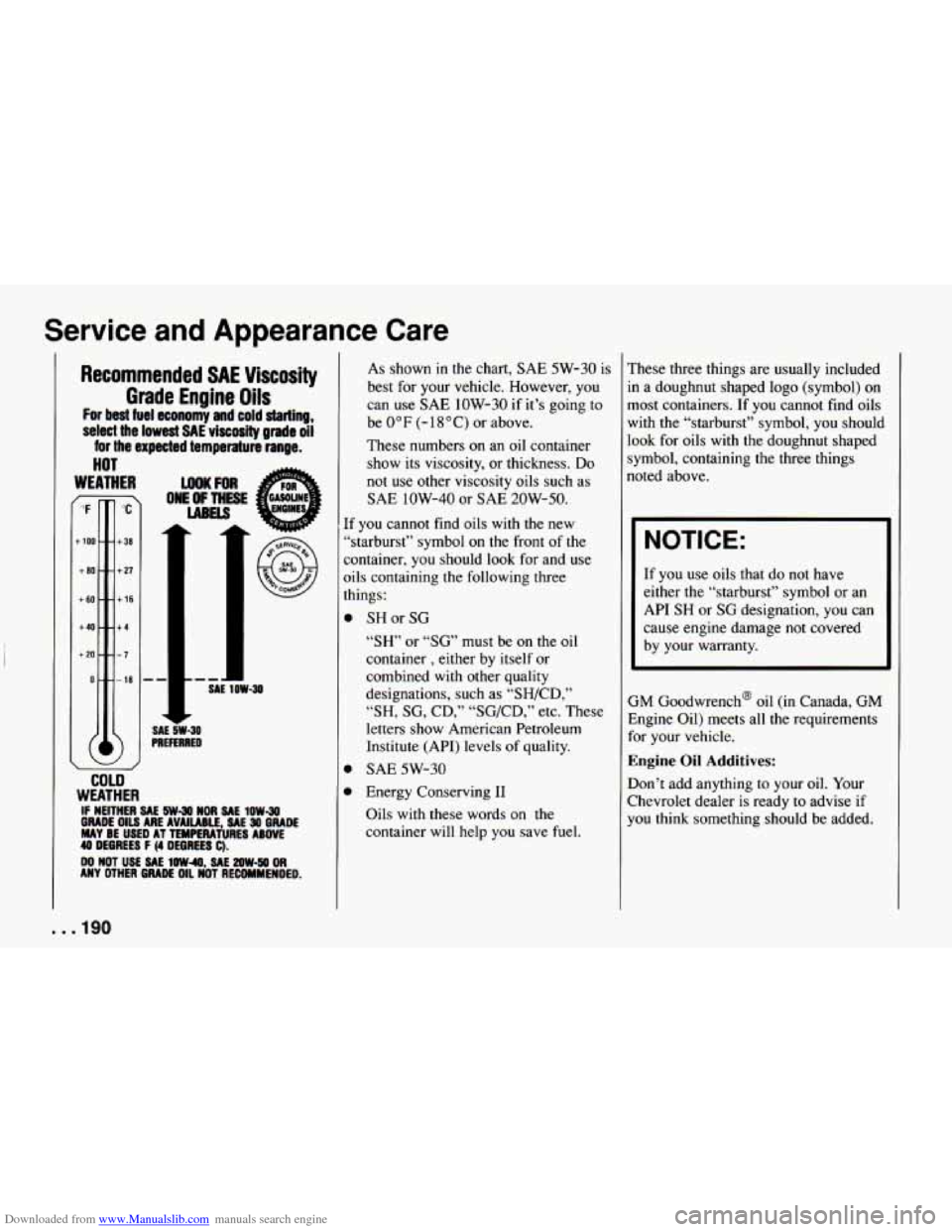
Downloaded from www.Manualslib.com manuals search engine Service ad Appearance Care
Recommended SAE Viscosity
Grade Engine Oils
For best fuel economy and cold starting,
select the lowest SAE viscosity grade oil
for the expected temperature range.
HOT
WEATHER
-
I
u)oKFoR
ONE OF THESE
LABELS
SAE CW-30 PREFERRED
COLD
WEATHER
IF NEITHER SAE 5W-M NOR SAL 10W.30
ORADE OIU ARE A E, ME 30 GRADE
40 DEGREES F (4 DEGREES C).
DO NOT USE SAE 1OW-40, SAE 2OW-50 OR ANY OTHER GRADE OIL NOT RECOMMENDED.
MAY BE USED AT Ttmr~nnTURES ABWE
As shown in the chart, SAE 5W-30 is
best for your vehicle. However, you
can use SAE
1OW-30 if it’s going to
be
0°F (-18°C) or above.
These numbers on an oil container
show
its viscosity, or thickness. Do
not use other viscosity oils such as
SAE 1OW-40 or SAE 20W-50.
[f you cannot find oils with the new
‘starburst” symbol on the front of the
;ontainer, you should look for and use
3ils containing the following three
:hings:
SH or SG
“SH’ or “SG” must be on the oil
container
, either by itself or
combined with other quality
designations, such as “SH/CD,”
“SH, SG, CD,” “SG/CD,” etc. These
letters show American Petroleum
Institute
(API) levels of quality.
SAE
5W-30
Energy Conserving I1
Oils
with these words on the
container will help you save fuel. These
three things are usually included
in a doughnut shaped logo (symbol) on
most containers.
If you cannot find oils
with the “starburst” symbol, you should
look for oils with the doughnut shaped
symbol, containing the three things
noted above.
NOTICE:
If you use oils that do not have
either the “starburst” symbol or an
API SH or SG designation, you can
cause engine damage not covered
by your warranty.
GM Goodwrench@ oil (in Canada, GM
Engine Oil) meets all the requirements
for your vehicle.
Engine Oil Additives:
Don’t add anything to your oil. Your
Chevrolet dealer
is ready to advise if
you
think something should be added.
. . .I90
Page 246 of 292
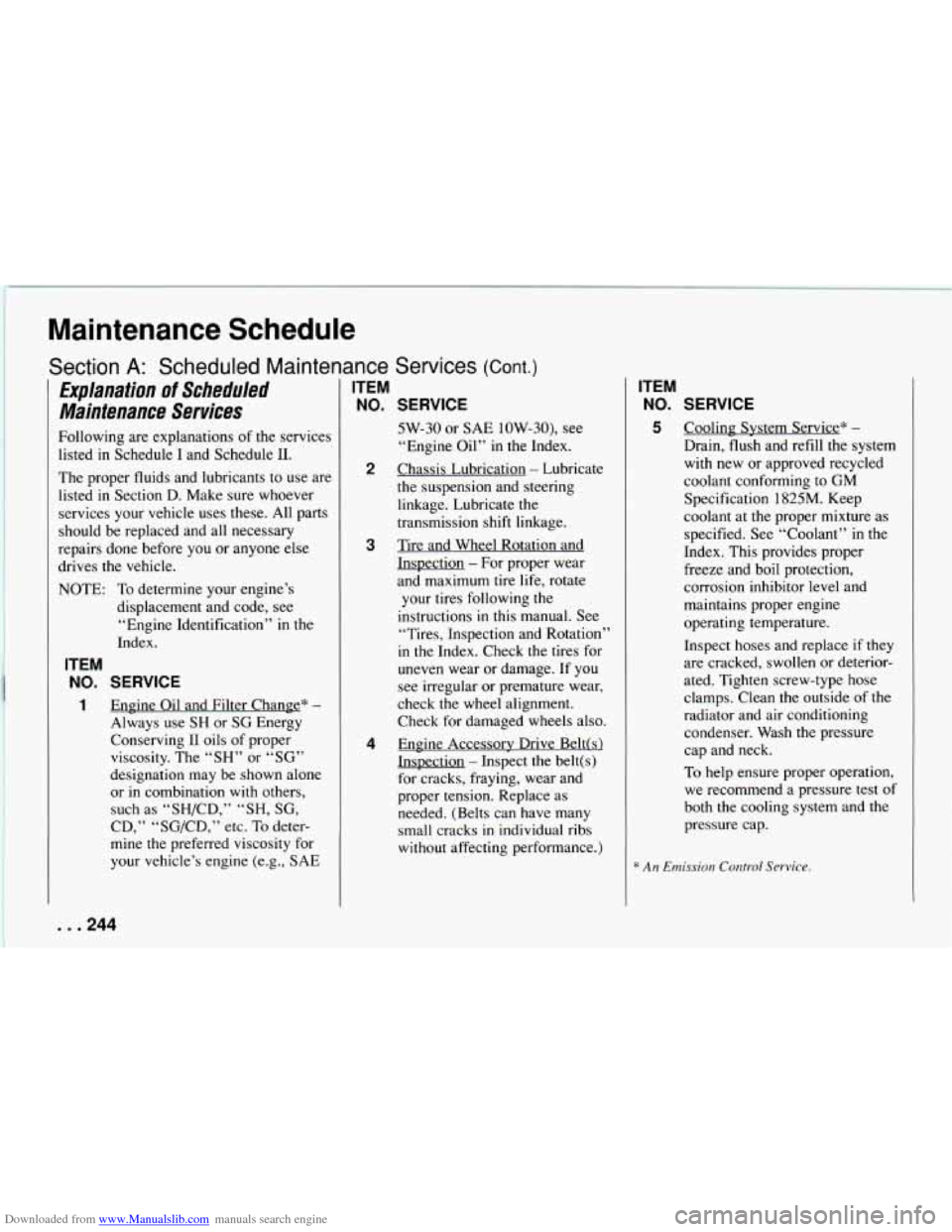
Downloaded from www.Manualslib.com manuals search engine Maintenance Schedule
Section A: Scheduled Maintenance Services (cont.)
Explanation of Scheduled
Maintenance Services
Following are explanations of the services
listed in Schedule
I and Schedule 11.
The proper fluids and lubricants to use are
listed
in Section D. Make sure whoever
services your vehicle uses these. All parts
should be replaced and all necessary
repairs done before you or anyone else
drives the vehicle.
NOTE: To determine your engine’s
displacement and code, see
“Engine Identification”
in the
Index.
ITEM
NO. SERVICE
1 Engine Oil and Filter Change” -
Always use SH or SG Energy
Conserving I1 oils of proper
viscosity. The
“SH” or “SG”
designation may be shown alone
or
in combination with others,
such as “SH/CD,”
“SH, SG,
CD,” “SG/CD,” etc. To deter-
mine the preferred viscosity for
your vehicle’s engine (e.g., SAE
ITEM
NO.
2
3
4
SERVICE
5W-30 or SAE 1OW-30)’ see
“Engine Oil”
in the Index.
Chassis Lubrication
- Lubricate
the suspension and steering
linkage. Lubricate the
transmission shift linkage.
Tire and Wheel Rotation and
InsDection
- For proper wear
and maximum tire life, rotate
your tires following the
instructions
in this manual. See
“Tires, Inspection and Rotation”
in the Index. Check the tires for
uneven wear or damage. If you
see irregular or premature wear,
check the wheel alignment.
Check for damaged wheels also.
Engine Accessory Drive Belt(s)
Inspection
- Inspect the belt(s)
for cracks, fraying, wear and
proper tension. Replace as needed. (Belts can have many
small cracks
in individual ribs
without affecting performance.)
ITEM
NO. SERVICE
5 Cooling System Service* -
Drain, flush and refill the system
with new or approved recycled
coolant conforming to
GM
Specification 1825M. Keep
coolant at the proper mixture as
specified. See “Coolant”
in the
Index. This provides proper
freeze and boil protection,
corrosion inhibitor level and
maintains proper engine
operating temperature.
Inspect hoses and replace
if they
are cracked, swollen or deterior-
ated. Tighten screw-type hose
clamps. Clean the outside
of the
radiator and air conditioning
condenser. Wash the pressure
cap and neck.
To help ensure proper operation,
we recommend a pressure test of
both the cooling system and the
pressure cap.
* An Emission Control Service.
. . .244
Page 253 of 292
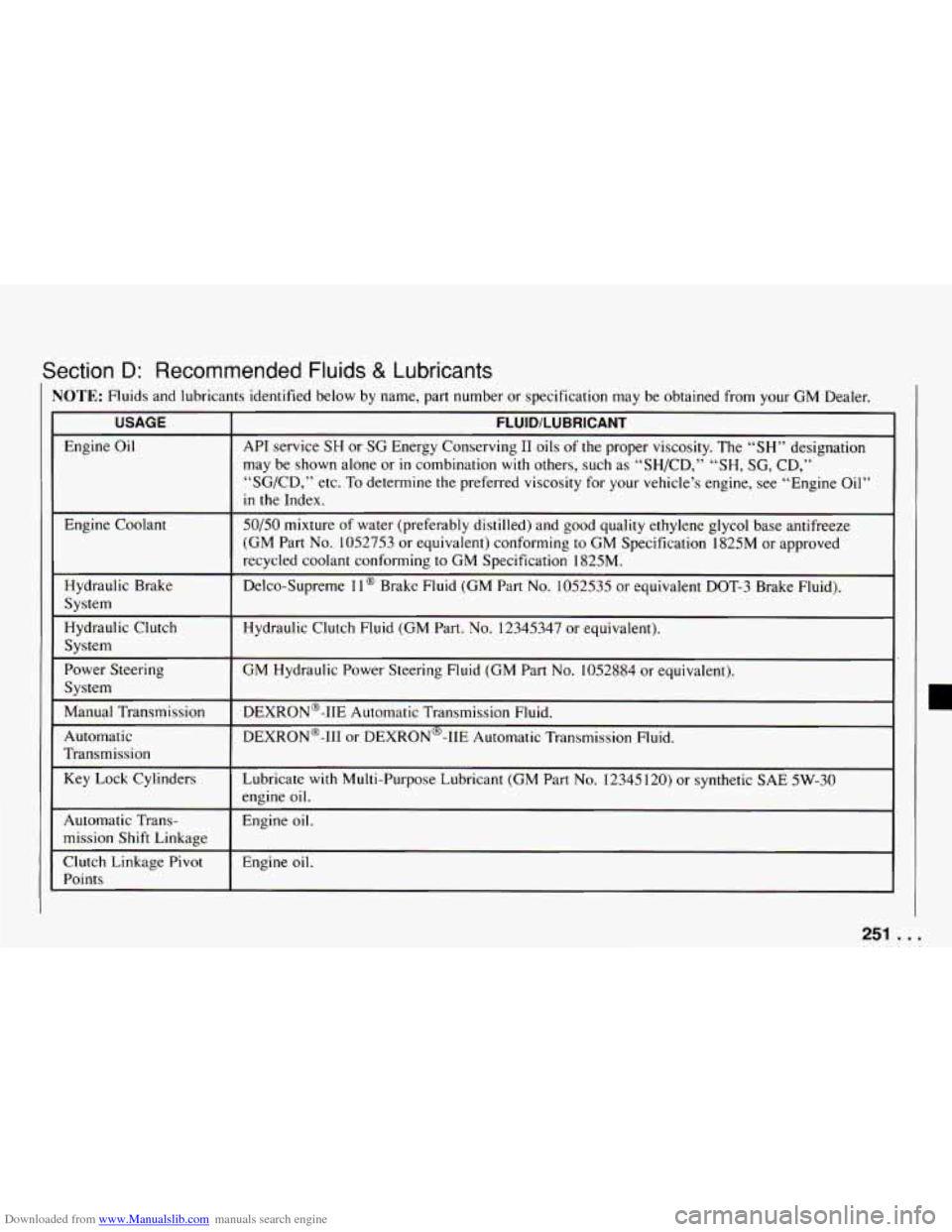
Downloaded from www.Manualslib.com manuals search engine Section D: Recommended Fluids & Lubricants
I NOTE: Fluids and lubricants identified below by name, part number or specification may be obtained from your GM Dealer.
USAGE
Engine Oil
Engine Coolant
Hydraulic Brake
System
Hydraulic Clutch
System
Power Steering
System
Manual Transmission
Automatic
Transmission
Key Lock Cylinders
Automatic Trans-
mission Shift Linkage
Clutch Linkage Pivot
Points
FLUID/LUBRICANT
API service SH or SG Energy Conserving I1 oils of the proper viscosity. The “SH” designation
may be shown alone
or in combination with others, such as “SH/CD,” “SH, SG, CD,”
“SG/CD,” etc.
To determine the preferred viscosity for your vehicle’s engine, see “Engine Oil”
in the Index.
50/50 mixture of water (preferably distilled) and good quality ethylene glycol base antifreeze
(GM Part No. 1052753 or equivalent) conforming to GM Specification 1825M or approved
recycled coolant conforming to GM Specification 1825M.
Delco-Supreme
11 @ Brake Fluid (GM Part No. 1052535 or equivalent DOT-3 Brake Fluid).
Hydraulic Clutch Fluid (GM Part.
No. 12345347 or equivalent).
- ~- -~~ --
~ M Hydraulic Power Steering Fluid (GM Part No. 1052884 or equivalent).
DEXRON@-IIE Automatic Transmission Fluid.
DEXRON@-111 or DEXRON@-IIE Automatic Transmission Fluid.
Lubricate with Multi-Purpose Lubricant (GM Part No. 12345
120) or synthetic SAE 5W-30
engine oil.
Engine oil.
Engine
oil.
251 . . .